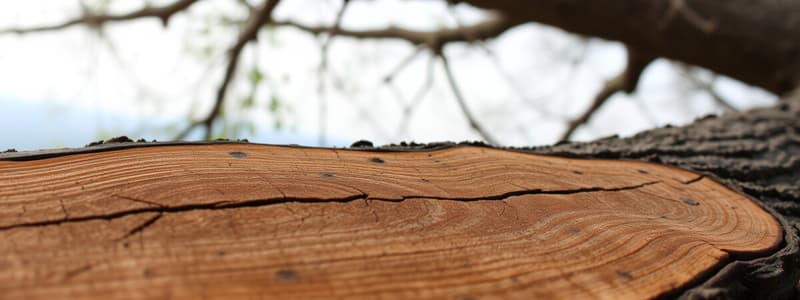Podcast
Questions and Answers
What does each growth ring in a tree represent?
What does each growth ring in a tree represent?
- A year of growth (correct)
- A decade of environmental data
- A season of growth
- A month of climate conditions
What do narrow tree rings typically indicate?
What do narrow tree rings typically indicate?
- Rapid growth conditions
- Drought conditions (correct)
- Abundant moisture
- Stable climate conditions
How does dendrochronology contribute to climate change understanding?
How does dendrochronology contribute to climate change understanding?
- By predicting future plant species
- By tracking current animal migrations
- By analyzing historical climatic conditions (correct)
- By measuring current atmospheric CO2 levels
What role do older trees and forests play in carbon sequestration?
What role do older trees and forests play in carbon sequestration?
What is required to enhance the accuracy of tree-ring data?
What is required to enhance the accuracy of tree-ring data?
Which aspect does tree-ring analysis NOT directly provide insights into?
Which aspect does tree-ring analysis NOT directly provide insights into?
How does climate change affect biodiversity in ecosystems?
How does climate change affect biodiversity in ecosystems?
What does tree-ring data help to indicate about forest health?
What does tree-ring data help to indicate about forest health?
What is a benefit of sustainable forestry practices informed by dendrochronology?
What is a benefit of sustainable forestry practices informed by dendrochronology?
Which of the following is NOT an indicator of climate change assessed through tree ring analysis?
Which of the following is NOT an indicator of climate change assessed through tree ring analysis?
Study Notes
Tree-ring Analysis
- Definition: Dendrochronology is the science of studying tree rings to understand environmental conditions.
- Growth Rings: Each ring represents a year of growth; the width and characteristics reflect climatic conditions (e.g., moisture, temperature).
- Data Extraction: Samples are taken from tree cores, allowing for analysis without cutting down trees.
- Age Determination: Helps in dating events, studying historical climates, and understanding growth patterns.
Climate Change Indicators
- Temperature Records: Tree rings can indicate past temperatures; wider rings often correlate with warmer, wetter years.
- Drought Evidence: Narrow rings typically signify drought conditions, revealing historical climate variability.
- Extremes Tracking: Analyzes frequency and intensity of extreme weather events over time, contributing to models of future climate scenarios.
- Calibration: Tree-ring data is calibrated with instrumental climate records to enhance accuracy.
Carbon Sequestration
- Role of Trees: Trees absorb CO2 during photosynthesis, storing carbon in wood and soil.
- Long-term Storage: Older trees and forests store significant amounts of carbon, contributing to climate regulation.
- Dendrochronology's Contribution: Helps estimate carbon storage potential of various forest types over time.
- Management Insights: Informs forest management practices to maximize carbon sequestration through sustainable forestry.
Impact On Ecosystems
- Habitat Changes: Climate change affects species distribution; tree-ring data provides insights into historical habitat shifts.
- Biodiversity: Shift in tree species due to climate conditions can impact overall biodiversity in ecosystems.
- Forest Health: Tree growth patterns indicate the health of forests; stressed trees may show reduced growth rates.
- Ecological Relationships: Understanding historical climate patterns aids in predicting how ecosystems will respond to ongoing climate changes.
Tree-ring Analysis
- Dendrochronology studies tree rings to reveal historical environmental conditions.
- Each growth ring indicates one year, with width and traits reflecting climate factors like moisture and temperature.
- Tree cores are sampled to gather data without harming the trees, preserving living specimens.
- This analysis assists in dating historical events, examining past climates, and recognizing tree growth trends.
Climate Change Indicators
- Tree rings serve as indicators of historical temperatures; wider rings suggest warmer and wetter conditions.
- Narrow rings often denote drought periods, highlighting variability in climate throughout history.
- The technique tracks the frequency and intensity of extreme weather, informing predictive climate models.
- Calibration with modern climate records enhances the accuracy of interpretations drawn from tree-ring data.
Carbon Sequestration
- Trees play a crucial role in carbon dioxide absorption during photosynthesis, sequestering carbon in their structure and surrounding soil.
- Older trees and established forests serve as significant carbon reservoirs, aiding in climate regulation efforts.
- Dendrochronology estimates the carbon storage potential among different forest types over time.
- Sustainable forestry management practices can be improved through insights from tree-ring data, maximizing carbon sequestration efforts.
Impact On Ecosystems
- Climate change influences species distribution, and tree-ring data provides valuable information on historical shifts in habitats.
- Changes in tree species distribution due to climate conditions may adversely affect overall biodiversity within ecosystems.
- The health of forests can be monitored through tree growth patterns; stressed trees are often indicators of declining forest health.
- Insights from past climate patterns enhance predictions of ecosystem responses to ongoing climate change challenges.
Studying That Suits You
Use AI to generate personalized quizzes and flashcards to suit your learning preferences.




